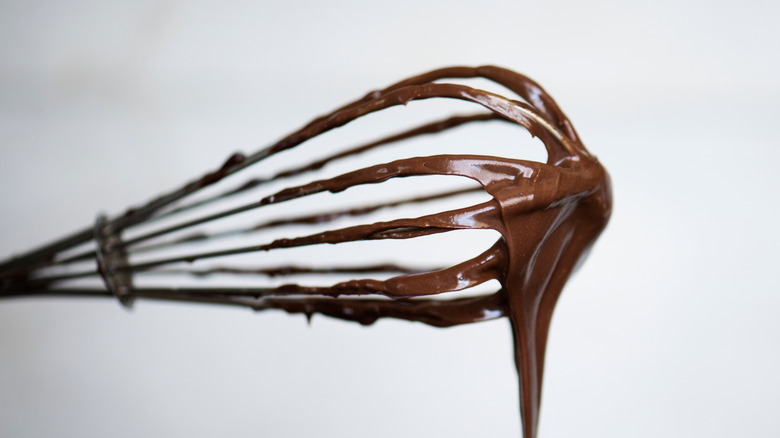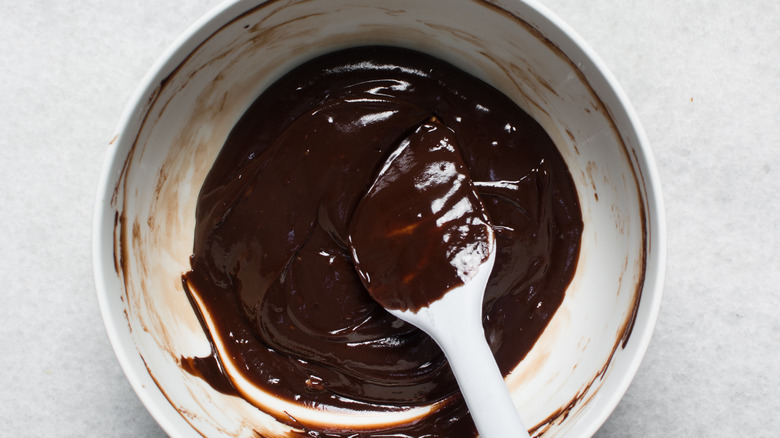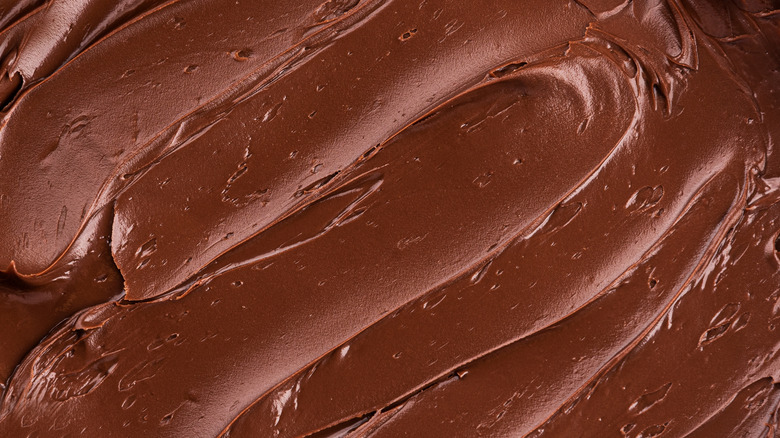The Major Mistake To Avoid When Thinning Out Ganache
When all goes well, homemade ganache is the easiest chocolate indulgence. As long as you follow the rules, it's a matter of mixing chocolate and cream over heat and giving it time to set. But sometimes, the rules run counter to what you'd expect. At Cindy's, the celebrated dining spot on top of Chicago's Athletic Association hotel, pastry chef Yami Mercado says consistency is key with ganache — but nailing the perfect texture is tricky.
"The ideal consistency really depends on what you're using it for," Mercado says. "The best consistency for piping or spreading should be about peanut butter consistency. If you need to fill truffles, then it should be smooth and pourable."
The answer to thinning a ganache that's too thick for the job might seem obvious: just add more cream. But according to Mercado, that's a major mistake. "I would not recommend adding more liquids to save a ganache. Adding more will mess up the ratio of liquid to chocolate," she says. "This will adversely affect the taste and texture!" On that note, adding cream straight from the fridge is an especially egregious mistake. "Adding in cold cream will shock the mixture and cause it to harden and clump. The clumping will cause it to break and become grainy," Mercado says.
Why you shouldn't add liquid to thin out ganache
To understand why you can't just add more liquid to ganache, allow us to offer you a mini crash course in chemistry. Ganache is an emulsion, or a mixture of liquids that don't want to mix. In cooking, that typically means fat and water. Ganache combines fat from the chocolate and water from the cream — along with a healthy dose of more fat.
Since fat and water don't mix, emulsions split apart easily. Some emulsions, like homemade vinaigrette, can split within hours. To create a stable emulsion that sticks together permanently, you'll need to add an emulsifier, or change the chemical structure. In the case of ganache, heat changes the structure of the fats and sugars.
But even permanent emulsions are delicate. An emulsion requires a specific fat-to-water ratio. If there's too much of one, the other will start clinging together in clumps. Ganache is already pretty fatty; add cream, and the fat overload will break your ganache. To fix an unbalanced ratio, slowly add small amounts of hot water, whisking as you go. The water will help keep the ratio in check.
How to fix ganache that's too thick
If your ganache is too thick, Yami Mercado recommends reheating it. "If you find the consistency too thick, reheat it to smooth it out!" she says. "It's usually best to reheat over a double boiler or even the microwave at a very low heat. Warm until it's liquid again and then let it set."
The best way to make a thinner ganache? Plan it out from the get-go. If you want standard ganache, use a 1:1 chocolate-to-cream ratio. For something a little thicker, up the chocolate. Remember, sugar and fat are key to keeping the balance in check. That may be bad news for dark chocolate lovers: rich, cocoa-heavy chocolate doesn't have enough of those two key ingredients to lead to a smooth mixture. Opt for something a little milkier to keep your ganache lump-free.
And if at first you don't succeed? Try, try again. Once you have ganache in your baking arsenal, you can use it to make entrancing ganache thumbprint cookies or use it as a frosting to level up boxed cake mix so it tastes homemade.


